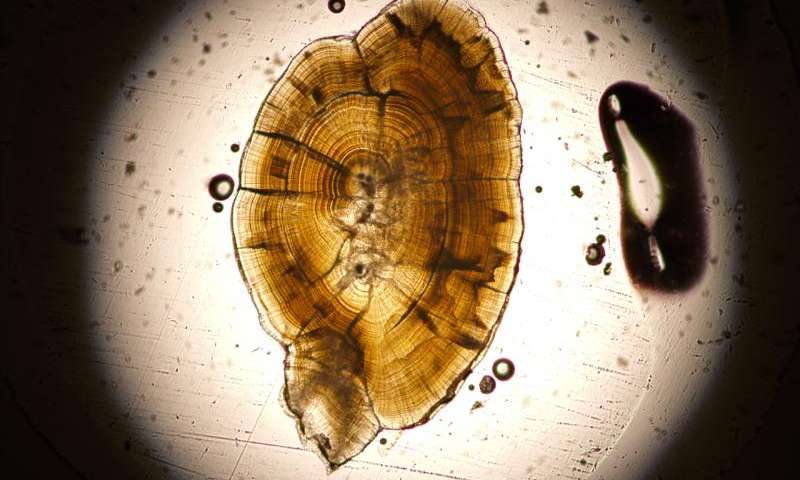According to a new study, just like tree rings carry with them hints about previous dry or rainy years, bones in fish carry with them a specific signature which records the chemical composition of the waters they used to live in.

A cross-section of a salmon otolith, also known as a fish ear stone or fish ear bone. Scientists measured Strontium ratios and identified the waters in which the fish lived for its entire life. The new fish-tracking method may help pinpoint critical habitats for fish threatened by climate change, industrial development and overfishing. Credit: Sean Brennan, University of Washington
Read more at: http://phys.org/news/2015-05-chemical-tags-ear-bones-track.html#jCp
Most vertebrates, especially fish, have what is called an ‘otolith’ – a specific bony structure inside the inner ear. The otolith accretes layers of calcium carbonate and gelatinous matrix throughout the entire life. The accretion rate varies with growth of the fish – often less growth in winter and more in summer – which results in the appearance of rings that resemble tree rings; and just like with tree rings, scientists can figure out the age. Another interesting fact is that the otolith isn’t really digestible, so it often remains stuck in the digestive tract of fish-eating animals, and scientists can therefore reconstruct their eating habits.
But whenever the otolith grows and accretes more calcium carbonate, it also traps in other elements – extremely small fractions of the chemical makeup of the waters in which the fish live in. Specifically, it traps in specific isotopes, in specific quantities; by analyzing these isotopes, researchers are now able to reconstruct where the fish was born and where it traveled for its entire life.
Sean Brennan from the University of Washington and lead author explains:
“Each fish has this little recorder, and we can reveal the whole life history of the fish from the perspective of the otolith. Each growth ring is a direct reflection of the environment the fish was swimming in at the time it was formed.” Brennan completed the study as a doctoral student at the University of Alaska Fairbanks. He is now a postdoctoral researcher in the University of Washington’s School of Aquatic and Fishery Sciences.
Specifically, they looked at the trace element strontium. Strontium is a very reliable element for this type of reconstructions because it almost never alters and strontium levels vary greatly depending on the age and structure of the bedrock. In other words, by looking at how the strontium in an area looks like you can figure out (to some extent) where it comes from. But it wasn’t an easy feat. Thure Cerling, also an author, explains:
“There are literally thousands of measurements on each otolith,” Cerling says.
Geochemist Diego Fernandez further adds:
“They’re like microexplosions. You create tiny, tiny particles that are carried into the mass spectrometer.” By showing how the ratio of strontium-87 to strontium-86 changed over time, “we get the entire life history of the salmon,” he says.
Some areas more than others are better candidates for this type of analysis, but researchers wanted a challenge – so they chose Alaska.
“Alaska is a mosaic of geologic heterogeneity,” he added. “As long as you can look at a geologic map and see rocks that are really different, that’s a good potential area.”
About 200,000 Chinook salmons make their way to the breeding grounds in Bristol Bay every year. When the eggs hatch in the spring, the little salmons spend a whole year in the river before venturing to the Bering Sea, and ultimately, the Pacific Ocean.
This is not only an extremely exciting find, but one that can have a great effect on fish populations throughout the world. By analyzing several otoliths, scientists can now see if their migratory patterns have remained similar, or if they have changed – likely due to some stress. From a conservation standpoint, that’s a game changer.
“This is science responding to a societal issue and need,” said co-author Christian Zimmerman, U.S. Geological Survey ecologist and chief of water and interdisciplinary studies at the USGS Alaska Science Center in Anchorage. “Using this approach, we will be able to map salmon productivity and determine how freshwater habitats influence the ultimate number of salmon. With declines in Chinook salmon in Western Alaska, fishery and land-use managers need better information about freshwater habitats to guide conservation.”
But it’s not just fish – the same technique could be used for other animals. Strontium is known to accumulate in bird feathers and teeth and also survives even after being fossilized. It could help us understand moving patterns better than ever.
Journal Reference: Sean R. Brennan, Christian E. Zimmerman, Diego P. Fernandez, Thure E. Cerling, Megan V. McPhee, Matthew J. Wooller. Strontium isotopes delineate fine-scale natal origins and migration histories of Pacific salmon. DOI: 10.1126/sciadv.1400124










